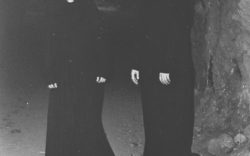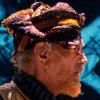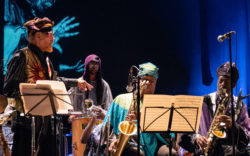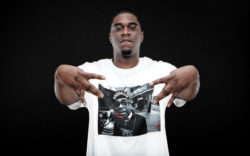“The difference between downstairs and upstairs seating is like night and day. Downstairs is like a sports bar, and upstairs is like a fine dining restaurant. It’s also a ton quieter upstairs as well, and there’s a whole other separate bar (would be great for renting out for holiday parties!).”
—Kenny C., from a Yelp.com review of St. Andrew’s Pub, 140 W. 46th St., New York, NY
On Mar. 2, 1974, a newly formed band called Television staged its first-ever performance at the Townhouse Theatre, located at 140 W. 46th Street in a near-bankrupt New York City. At present, things have changed, and they’ve changed all over. Even the band’s more well-known scenes of sonic activity have undergone transformations. Max’s Kansas City closed its doors in 1981; its space is currently occupied by a Korean deli. On the Bowery, the infamous CBGB club now houses a retail location for menswear designer John Varvatos. Some of the “rock memorabilia” of CBGB has been granted immunity and allowed to retain some nostalgic space in Varvatos’ store—alongside $2,000 jackets, of course.
If all that remains of these punk meccas is a few token physical remnants, so be it. One can surmise that nostalgia played little role in the game plan Television laid forth at the outset. The fashion of the New York City punk scene was never the group’s focal point, leaving the iconic leather to forerunners like the Ramones.
Stylistically, the members of Television galvanized as much as they divided, ascribing to the portions of the punk aesthetic they wished to emulate (musical economy, individualistic attitude) and discarding what they regarded as unnecessary (simplistic harmony, party-line subject matter). Standing in for stereotypical punk moves were lyrical images drawn from French poetry and guitar heroics that echoed the great American electric tradition.
The weight of these choices cannot be understated today. Punk’s lean meat was meant to carry with it a raw liberation from rock music’s stodgy, early-’70s development into haughty, experts-only prog dross. By re-asserting the improvisatory guitar solo as a major aspect of its futuristic version of punk, Television played the role of pariah in the eyes of the purists. Communistic egalitarianism! No experts allowed! Up the punks, and up the punks only!
But Television’s classic lineup—vocalist and guitarist Tom Verlaine, guitarist Richard Lloyd, drummer Billy Ficca and bassist Fred Smith—had a greater grasp on the psychic immediacy that punk could offer than these crusty naysayers. Through their bold improvisations and signature rave-ups, they remembered their forebears’ implicit statement of intent: embodiment of the present via psychedelic searching.
The solos on the band’s ’70s LPs, Marquee Moon and Adventure, picked up a frayed thread once carried by the Byrds’ Roger McGuinn on “Eight Miles High,” by John Coltrane on “A Love Supreme” and by the traditional Indian music that turned Coltrane’s mind towards a life of spiritually inquisitive performance. By fusing that timeline with the basics-first restraint practiced by the Velvet Underground, the Modern Lovers and other contemporaries down on the Bowery, Television created a perfect balance between punk’s insistence on an absence of frills and psychedelic rock’s personal exigency.
So what if the locations the group once vibrated with its mighty, brainy sound no longer bear the same names—fuck it. Television was always about living in the moment. All is fluid along time’s unforgiving trajectory.
So that’s our history lesson. What of the sky-struck rando development that is Television’s current three-stop U.S. tour? What do audiences in San Francisco, Austin and Athens (and abroad) have to expect from a band that has been off-and-on (with an emphasis on “off”) since 1992?
Band members weren’t available to interview, so we have to glean scant facts where we can find them. We do know that Richard Lloyd is no longer with Television, following an amicable break in 2007. In his place, an old-hand session man named Jimmy Rip is playing alongside Verlaine. The interplay between Verlaine and Lloyd is a crucial element of Television’s delicate chemistry, but fans may find some solace in the information that when Mick Jagger records or performs solo, Rip has traditionally been his guitarist of choice. (Take that however you wish, but at least admit that Rip is no stranger to filling considerably sized boots.)
We might turn to a few archival resources to get an idea of what the most in-the-moment punk band ever might be like in front of our own eyes. The group’s most popularly known live document, The Blow Up, sees it wholeheartedly embracing the past with a slack take on Bob Dylan’s “Knockin’ on Heaven’s Door,” doused with harmonics and deliberate group dynamics. It emphasizes the fact that Television rarely employs textures that showcase a single instrument: it is a unit force, reliant on each member’s presence to fully inhabit a collective sound.
Another live album with superior sonic quality, Live at the Waldorf, takes the group to the historically loaded setting of San Francisco and sees it both shine and blast. The rhythm section’s playing could almost be described as delicate on “Venus,” while “Foxhole” rides a wave of cool menace. And while the term “rave-up” is almost a cliché when discussing the first hippie punks, Television neatly defines the term at the close of “Ain’t That Nothin’,” among other songs. Finally, a BBC performance available on ye olde YouTube betrays Ficca’s traditional “jazz grip”; the viewer bears witness to the band’s sublime nonchalance.
While Verlaine’s leads—circuitous, unpredictable, a personification of electricity—are what define the group’s controlled improvisations, it should be understood that there isn’t a moment of recorded Television that one would describe as “aimless.” An alternate version of the band’s signature song, the sprawling tone poem “Marquee Moon,” nearly exactly matches the album version in duration. The expansive vision that Verlaine and company set forth way back in 1974 can be viewed as an insistence on maximum exploration while remaining firmly in the now. That is, it doesn’t matter where you are, as long as you’re right there.
WHO: Television, T. Hardy Morris
WHERE: Georgia Theatre
WHEN: Thursday, Nov. 7, 8 p.m.
HOW MUCH: SOLD OUT!
Like what you just read? Support Flagpole by making a donation today. Every dollar you give helps fund our ongoing mission to provide Athens with quality, independent journalism.










